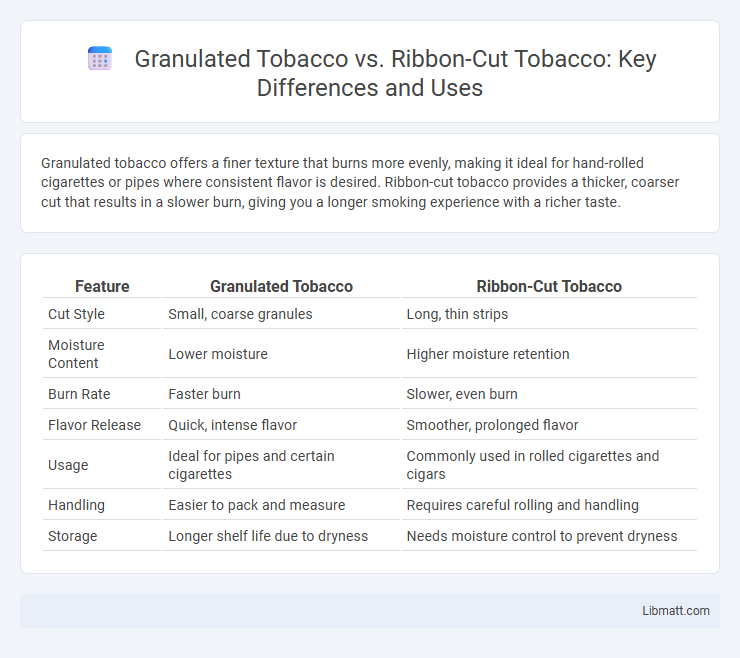Granulated tobacco offers a finer texture that burns more evenly, making it ideal for hand-rolled cigarettes or pipes where consistent flavor is desired. Ribbon-cut tobacco provides a thicker, coarser cut that results in a slower burn, giving you a longer smoking experience with a richer taste.
Table of Comparison
| Feature | Granulated Tobacco | Ribbon-Cut Tobacco |
|---|---|---|
| Cut Style | Small, coarse granules | Long, thin strips |
| Moisture Content | Lower moisture | Higher moisture retention |
| Burn Rate | Faster burn | Slower, even burn |
| Flavor Release | Quick, intense flavor | Smoother, prolonged flavor |
| Usage | Ideal for pipes and certain cigarettes | Commonly used in rolled cigarettes and cigars |
| Handling | Easier to pack and measure | Requires careful rolling and handling |
| Storage | Longer shelf life due to dryness | Needs moisture control to prevent dryness |
Understanding Granulated Tobacco
Granulated tobacco consists of fine, uniformly shredded particles that offer faster combustion and even burning compared to ribbon-cut tobacco, which is sliced into long, narrow strips. Granulated tobacco's smaller particle size enhances flavor intensity and moisture absorption, making it popular for roll-your-own cigarettes and pipe smoking. This form promotes quicker ignition and consistent smoke delivery, catering to users seeking a smoother and more controlled tobacco experience.
What Is Ribbon-Cut Tobacco?
Ribbon-cut tobacco consists of thin, long strips of cured tobacco leaves, designed to burn evenly and provide a smooth smoking experience. This format is commonly used in hand-rolled cigarettes, offering consistent moisture retention and ease of packing. Compared to granulated tobacco, which is chopped into small particles for quicker burning, ribbon-cut tobacco delivers a more controlled and flavorful smoke.
Key Differences: Granulated vs Ribbon-Cut
Granulated tobacco features small, loose particles that allow for faster burning and easier mixing with other substances, while ribbon-cut tobacco consists of long, thin strips providing a slower, more consistent burn ideal for rolling your own cigarettes or pipes. Granulated tobacco is often preferred for its quick ignition and ease of packing, whereas ribbon-cut tobacco offers a traditional texture and flavor experience. Choosing between the two depends on your smoking method and preference for burn rate and tobacco handling.
Manufacturing Process Comparison
Granulated tobacco undergoes a curing and grinding process that breaks the leaves into small, uniform granules suitable for moist or smokeless tobacco products. Ribbon-cut tobacco is produced by slicing whole cured leaves into long, thin strips, maintaining leaf integrity for rolling or pipe use. The granulation process enhances surface area and moisture retention, while ribbon-cut preserves leaf structure, affecting flavor release and combustion properties.
Texture and Consistency Explained
Granulated tobacco features small, coarse particles that provide a loose and easily packed texture, resulting in more consistent airflow and faster burning when compared to ribbon-cut tobacco. Ribbon-cut tobacco consists of long, thin strips that offer a denser, more compact feel, which slows the burn rate and produces a thicker smoke. The choice between granulated and ribbon-cut heavily influences the smoking experience due to these fundamental differences in texture and consistency.
Tobacco Packing and Handling
Granulated tobacco offers superior packing efficiency due to its fine, uniform texture, allowing for consistent density and reduced air pockets in storage containers. Ribbon-cut tobacco, with its long, narrow strands, requires more careful handling to prevent tangling and uneven compression during packaging. Your choice between these types impacts both the ease of packing and the preservation of tobacco freshness during transport and storage.
Smoking Experience: Flavor and Burn
Granulated tobacco offers a faster burn and more intense flavor release due to its smaller particle size, providing a sharper and more concentrated smoking experience. Ribbon-cut tobacco burns more slowly and evenly, delivering a smoother, longer-lasting flavor that allows you to savor each puff. Your choice between the two will significantly impact the flavor intensity and duration of your smoke.
Popular Uses for Each Cut
Granulated tobacco is primarily used for pipe smoking and roll-your-own cigarettes due to its fine texture, allowing for easier packing and even burning. Ribbon-cut tobacco is favored in traditional cigarette manufacturing and hand-rolling, providing a consistent cut that ensures smooth airflow and controlled combustion. Both cuts cater to specific preferences in tobacco consumption, with granulated tobacco offering more versatility for customized blends.
Pros and Cons of Granulated and Ribbon-Cut
Granulated tobacco offers faster burning and easier packing, making it ideal for hand-rolled cigarettes and pipe smokers seeking convenience and consistent burn. Ribbon-cut tobacco provides a slower, cooler burn with enhanced flavor and moisture retention, favored by those who prioritize taste and traditional smoking experience. Your choice depends on whether you value quick smoking and ease or a richer, longer-lasting flavor.
Choosing the Ideal Cut for Your Needs
Granulated tobacco offers a finer texture that burns evenly, ideal for rolling cigarettes or blending with other tobaccos for a smoother smoke. Ribbon-cut tobacco features long, thin strips that provide a richer flavor and longer burn time, making it suitable for pipe smoking or hand-rolled cigars. Selecting the ideal cut depends on your preferred smoking method and desired flavor intensity, with granulated cuts favoring convenience and ribbon cuts enhancing taste and duration.
Granulated tobacco vs ribbon-cut Infographic

 libmatt.com
libmatt.com